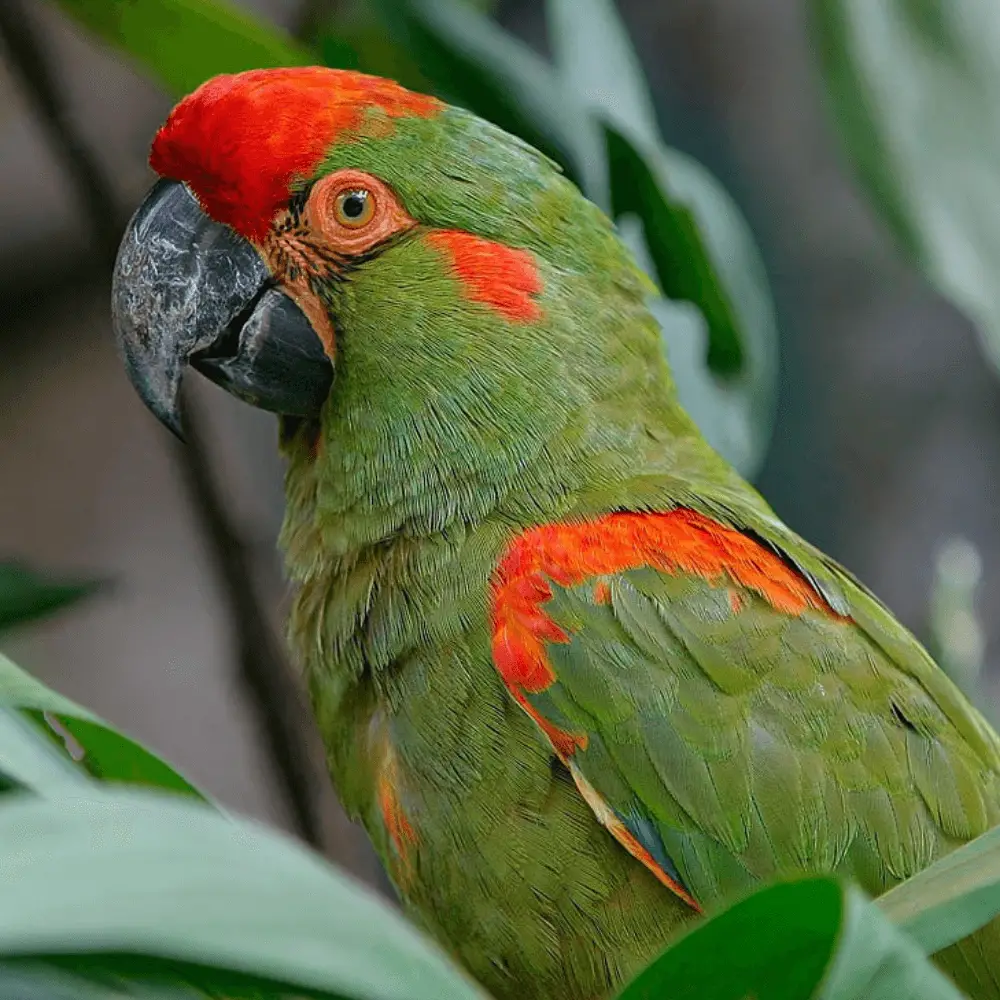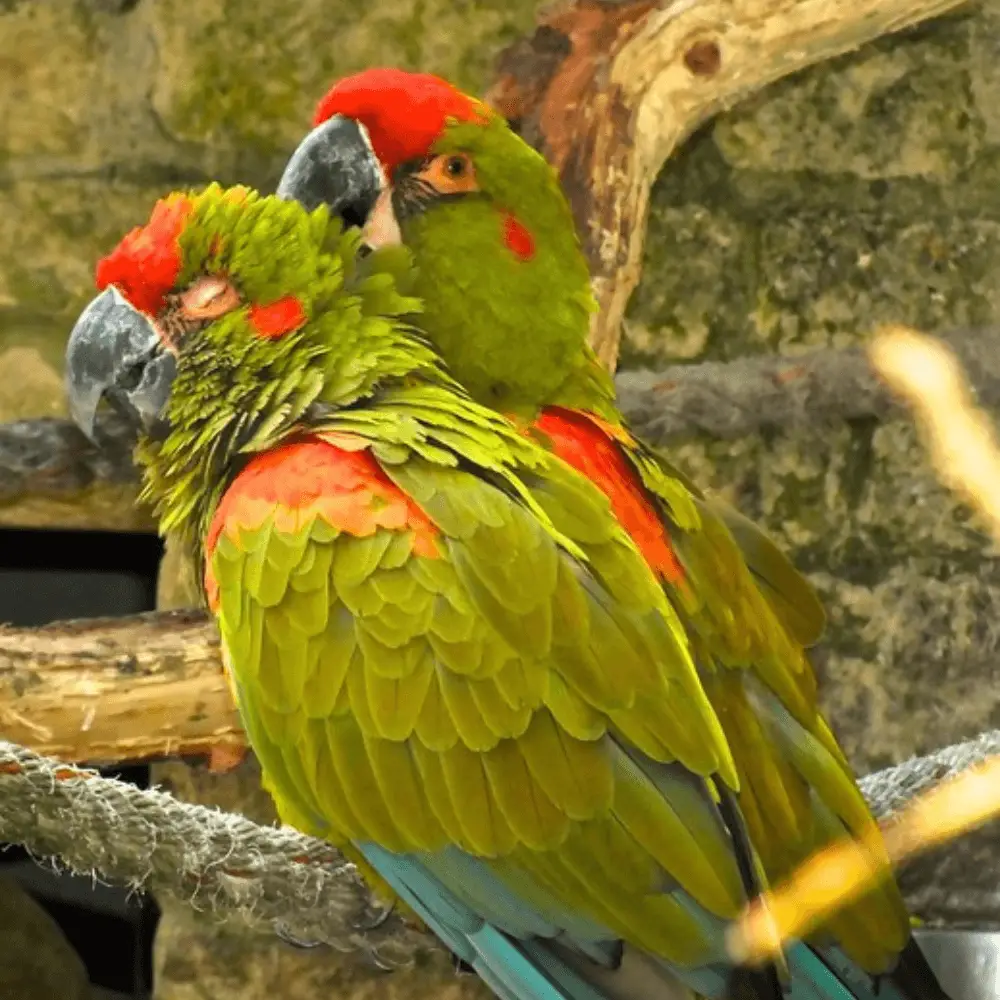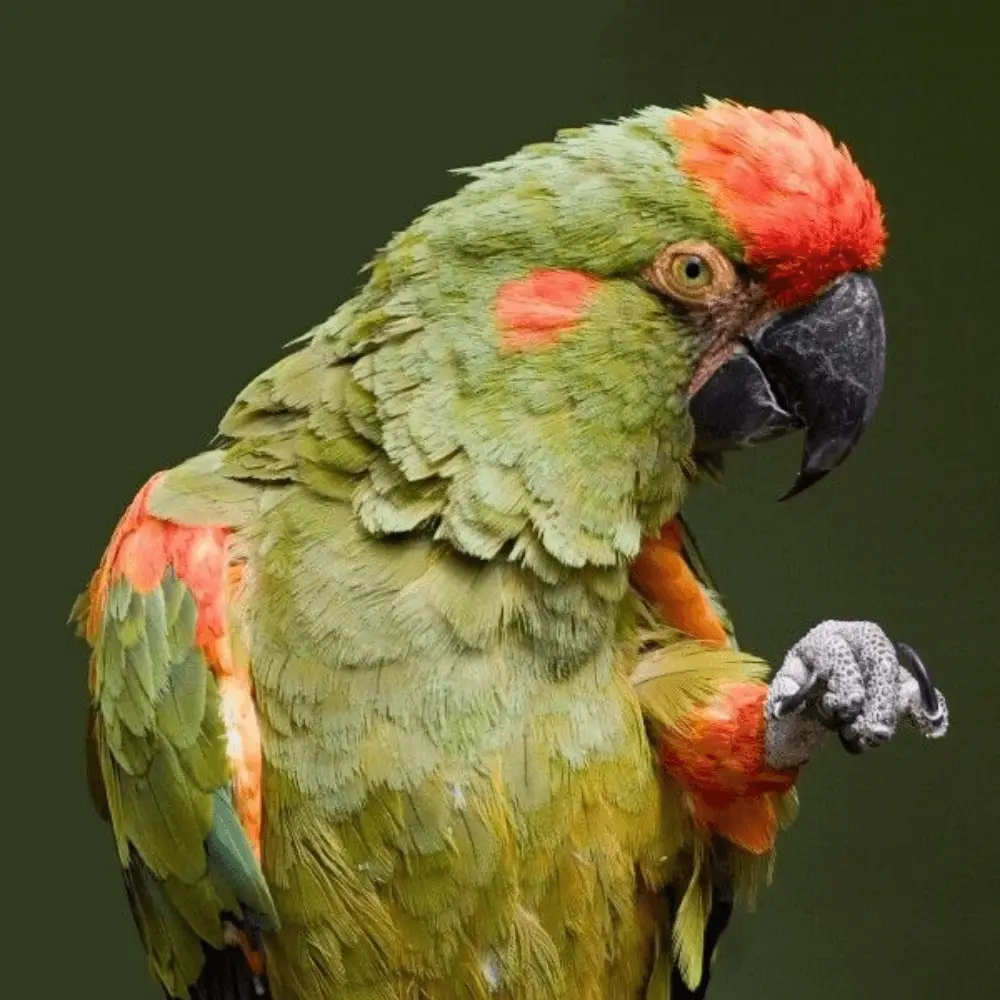Red-fronted macaw: About 55cm. length and 525 g. weight. (Ara rubrogenys) they are the smallest of the Macaws. They have front, old lords, crowns, and some bright orange-red helmet ears.
back of the crown, nape Yes mantle color olive green orange color in some tip feathers; brown-oliva collars; Grupa Yes upper-tail-coverts olive green, pale that of the mantle.
Lesser Coberteras, wing folding Yes orange-red carpal tunnel edge; medium covers olive green, a few hints of pale orange, the outermost suffused blue; large wings mostly blue, more olive back to body; outer webs primary blue, inner olive green. Juvenile red-orange underwing coverts, remaining tan olive-green rest.
The underparts are olive green with the thighs red. From above, the blue tail feathers of olive-blue color suffusion Tip and; below, yellowish olive green.
The dark gray bill; the strict domain of the upper lords and cheeks, white crossed with narrow lines of dark brown feathers; Orange the iris; ring perioftalmico White; dark gray legs.
Young is more opaque, with the orange-red color less extended in the head and in the ears of the helmet and without the red-orange in the wing.
- Order : Psittaciformes
- Family: Psittacidae
- Genus: ARA
- Scientific name: Ara rubrogenys
- Quote: Lafresnaye , 1847
- Protonimo: Ara rubro-pivert
- Origin: Bolivia
- Character: Intelligent and curious.
- Longevity: 24 years
- Height: 55 to 60 cm.
Habitat

The Red-fronted macaw is very selective in the search for its preferred habitat. It prefers subtropical scrubland Xeric or semi-desert areas with many Cacti (including Cereus, Neocardenasia, Cleistocactus, Echinopsis, Opuntia, Quiabentia and the endemic Lobivia caineana ) and areas dotted with trees and shrubs (especially legumes including Prosopis kuntzei, Acacia Fragrance, Cnidoscolus and Schinus molle species ).
Another fundamental feature of the habitat of the Red-fronted macaw they are the steep slopes Yes coastal cliffs unchanged to that used for nesting and resting sites.
They are social parrots and rarely stand alone. We often see flying in small groups of 3 to 5 individuals. For most activities such as feeding or roosting, they gather in large groups of 20-30 individuals. They rest frequently in the middle of the day during the hottest hours.
Distribution
The Red-fronted macaw is endemic to a small area east of the Andes, in south-central Bolivia, from southern Cochabamba and western Santa Cruz, passing Chuquisaca, east of Potosi, especially in the valleys of Grande Rivière, Mizque Oui Pilcomayo.
The full range estimate is 20,000 km², with 18,000 km² in the Grand / Mizque system Yes 2,000 km² in the Pilcomayo Valley, between 1,100 Yes 2,500 m (local after breeding at 3,000 m).
They perform several local movements in response to food availability.
Locally common, but declining and globally endangered.
Reproduction

Observed loose nests or colonies in ravine holes on the banks of rivers. In the rainy season, the laying has been reported during the months of November to April. They are 1 to 3 eggs per season, usually two, and the incubation lasts around 26 days. Most pairs fledge with one young per year.
They form monogamous bonds they maintain throughout the year. Even during the off-season of breeding, copula and preening occur exclusively between the consolidated pair, presumably to maintain their bond.
Generally speaking, they are not territorial, but during the breeding season, You can defend the area surrounding the nest cavity.
Food

The Red-fronted macaw diet includes seeds and fruits that include the various plant genera Cenchrus, Tribulus, Cnidoscolus, legumes Prosopis kuntzei, P. mesquite, Prosopis chilensis, trees and shrubs of the genus Aspidosperma, Schinus molle, Ziziphus mistol Yes Jatropha ricinifolia.
However, natural food is often scarce and birds feed, to a large extent, on cultivated plants, in particular the peanuts Arachis hypogaea Yes maize unripened cheeses .
Endangered
• Current IUCN Red List : Danger
• Demographic trend: Degressive
This species has a very small and dwindling population. Conservative estimates indicate that all subpopulations are extremely small. So qualified endangered.
Red-fronted macaw in captivity
Uncommon in captivity.
It is an extremely curious and intelligent bird that has the ability to imitate the human voice, despite the fact that the natives of Bolivia call them “bird donkeys”, due to their inability to speak. All skills require training; the holders of these bird breeders prove how easy it is to talk.
As for its longevity, sources say a pair of these macaws are still breeding after 23 years in captivity. It has been reported that these animals can live up to 36.2 years in captivity, something possible but unverified; the same study reported that these animals can reproduce at the age of 3 years in captivity.
Due to the few specimens that are released and their status in danger of extinction, Red-fronted macaw is recommended only for experienced breeders and handlers.
Related article:

